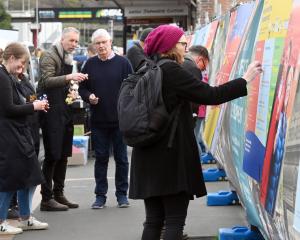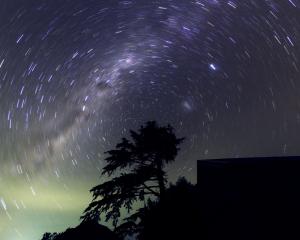About 9.20 in the evening, what sounded like an enormous, badly tuned diesel engine rumbled into life, shaking the yacht Elwing.
Why on earth was skipper Arthur White starting the engine at this time of night? But it only took a moment to realise this was not Elwing's engine - it was much bigger and vibrated more violently, sounding like a huge train bearing down on us.
"It's an earthquake. Hold on!" shouted Arthur as the rumbling and shaking continued for perhaps half a minute - none of us was counting.
The noise and vibrations finally ceased, but an ominous rumble turned into a thunderous roar and we realised a large slip was falling down a mountain nearby, crashing and breaking trees.
It was too dark to see anything and we just hoped it wasn't falling into the formerly quiet cove in which we had anchored for the night.
Six of us, with friends Arthur and Barbara White, were exploring Dusky Sound last week on their 14-metre yacht Elwing.
Sheltered by a rocky, bush-covered island, we had anchored in Cormorant Cove, on the western side of Resolution Island.
When we arrived in the late afternoon it was quiet - eerily so, one of our party remarked later.
The sky was overcast and the water in the cove was like glass.
A river with a wide estuary in the far corner had built a large sandy delta across half the bay and picturesque layers of mist hung mysteriously among the mountains.
Although we'd noticed more birdsong around Dusky Sound than on a trip four years ago, there were no birds singing in this cove that evening.
Later, shocked and shaken by the earthquake, we gathered in the small saloon.
There was no television or telephone in this remote spot, and even Meri Leask on Bluff Fishermen's Radio, Elwing's main outside contact, could not be reached from this remote cove, tucked away behind the mountains of Resolution Island.
But Arthur, experienced skipper that he is, was not relaxing.
All his senses were on alert.
He was expecting a tsunami, and sure enough, about 15 or 20 minutes later a strange bubbling sound came from the front of the boat.
It sounded like a truckload of gravel falling into the water beside Elwing, then there was a violent bump that almost knocked us off our feet.
Arthur leapt up the companionway, shouting: "Look out! We're in the trees. Start the engine, Barb!"And then all hell seemed to break loose.
Arthur, Barbara and the two men on the trip were on deck working.
We four women, under Arthur's instructions, were below, packing warm things into bags, finding matches, food and other things we might need if we had to abandon ship.
We had to remain below so as not to get in the way on the small deck.
It was a tense couple of hours.
Above us, the motor revved and strained, there were shouts and the rattle of the anchor chain, and footsteps running as Arthur drew on his considerable experience to save Elwing.
After about half an hour Barbara came below to replace torch batteries and told us the river seemed to have changed its course and the water, turbulent with branches and other debris, was swirling all around.
The anchor had dragged but luckily the stern line had held.
What had happened, Arthur told us later, was the tsunami had dragged water out of the bay, returned and swept up the river.
Then, as it rushed out again, it caused rapids over the end of the sandbank and whirlpools as it converged around the island behind which we were anchored.
The earthquake and raging water had dislodged the anchor and dragged it into the gut between the small island and the mainland, taking Elwing with it.
Luckily, the stern line, attached to a tree on the island, held and two inflatable dinghies had cushioned her from the worst of the rocks.
The dinghies were squashed fit to burst, he said.
We were up at bush level, the rudder and one of the twin keels were on a rock tipping the boat, which could have rolled.
It was only when another surge came that Arthur was able to get her off, but it was a struggle to keep her under control in the turbulence, especially while towing the anchor.
The anchor had to be retrieved and reset even more firmly than usual, and several more ropes tied to trees on the shore to hold her.
But as Arthur took the ropes ashore in the dinghy he worried that another slip might occur above him as he was securing them.
The task was made more difficult by the darkness - there was only the mast lights, torches and a spotlight to illuminate the dark.
To the south we could see a bright glow reflecting off the cloud from the brilliant lights on the fishermen's barges near Luncheon Cove.
We wondered how they had fared.
About midnight the water seemed to have calmed and we felt reasonably secure.
After a hot chocolate, some of us went to bed - not to sleep much, but to listen to the aftershocks that rumbled like distant trains on and off during the night.
In the morning the sky was clear, the air calm, the sun bright and the bush full of birdsong.
The only evidence of the night's happenings were the muddy water with a few leaves and twigs, and a raw scar on the mountain nearby.
The slip had, luckily, fallen on to land rather than into the water.
The damage to Elwing was minimal - just a nick out of the rudder.
But the rumbles, some large ones making us jump, continued irregularly through the rest of our week in Dusky.
As we motored out of Cormorant Cove into the larger Goose Cove, Arthur exchanged anecdotes by radio with the other couple of boats that had been in the sound that night, Doc's Southern Winds which had been landing and servicing trappers, and a fishing boat.
One had touched the bottom when three metres of water receded from Luncheon Cove and said the water rushed back like a wall down the narrow channel.
Seals apparently jumped on the Doc boat (one is said to have been trapped in the toilet) and on to fishermen's barges moored nearby.
Another boat, which had been in Doubtful Sound, said the waterfall in Deep Cove had stopped during the earthquake.
There seemed remarkably few slips around the hillsides, but that may have been because the land was so dry and because of the slow, rolling motion of the quake.
However, a couple of days later, motoring up the sound alongside Cooper Island in rain, we came across a new slip, with trees and debris floating in the water, and no doubt further slips will occur.
The remoteness of places like Fiordland are part of their attraction, but you have to be self-reliant, Arthur says.
You have to get yourself out of trouble as no-one else is going to be able to help you.
Even if the EPIRB (emergency position-indicating radio beacon) had been set off, help would not have come for some time.
And as we sailed down the calm sound in the sunshine next day, it was salutary to remember that earthquakes and geological events like the previous night's had built this remarkably wild and spectacular landscape over millions of years - and continue to do so.
The quake
A 7.8 magnitude earthquake with its epicentre in Dusky Sound struck the Fiordland region at 9.22pm on July 15, 2009.
It was the biggest since the Buller and Hawkes Bay earthquakes of 1929 and 1931, respectively, according to GNZ science and the Earthquake Commission's website, www.geonet.org.nz.
The motion was slower, with lower-frequency shaking and "rolling", rather than the sharp, higher-frequency shaking movements that cause building damage; this also explains the low number of landslides.
This, and the remoteness of the epicentre, means that New Zealand has been very fortunate.
If this earthquake had happened somewhere else, it could have caused huge damage, even with the mitigating low-frequency behaviour.













